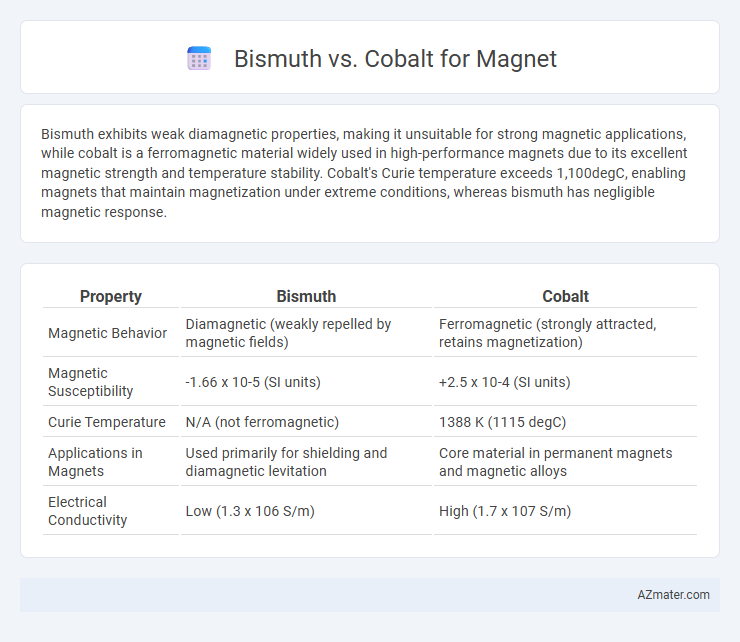Bismuth exhibits weak diamagnetic properties, making it unsuitable for strong magnetic applications, while cobalt is a ferromagnetic material widely used in high-performance magnets due to its excellent magnetic strength and temperature stability. Cobalt's Curie temperature exceeds 1,100degC, enabling magnets that maintain magnetization under extreme conditions, whereas bismuth has negligible magnetic response.
Table of Comparison
| Property | Bismuth | Cobalt |
|---|---|---|
| Magnetic Behavior | Diamagnetic (weakly repelled by magnetic fields) | Ferromagnetic (strongly attracted, retains magnetization) |
| Magnetic Susceptibility | -1.66 x 10-5 (SI units) | +2.5 x 10-4 (SI units) |
| Curie Temperature | N/A (not ferromagnetic) | 1388 K (1115 degC) |
| Applications in Magnets | Used primarily for shielding and diamagnetic levitation | Core material in permanent magnets and magnetic alloys |
| Electrical Conductivity | Low (1.3 x 106 S/m) | High (1.7 x 107 S/m) |
Introduction to Bismuth and Cobalt as Magnetic Materials
Bismuth exhibits diamagnetic properties, making it weakly repelled by magnetic fields, and is often used in applications requiring minimal magnetic interference. Cobalt is a ferromagnetic metal with strong magnetic properties, widely utilized in permanent magnets, magnetic recording media, and high-strength alloys. The contrasting magnetic behaviors of bismuth and cobalt significantly influence their respective roles in magnetic material technologies.
Atomic Structure and Magnetic Properties
Bismuth exhibits a rhombohedral crystal structure and is diamagnetic due to its paired electrons and weak spin-orbit coupling, resulting in negligible magnetic susceptibility. Cobalt has a hexagonal close-packed (hcp) atomic structure at room temperature and strong ferromagnetic properties stemming from unpaired 3d electrons and exchange interactions that align magnetic moments. The contrasting electron configurations, with Bismuth's 6p orbitals fully paired and Cobalt's 3d orbitals partially filled, fundamentally determine their divergent magnetic behaviors in magnet applications.
Magnetic Susceptibility: Diamagnetism vs Ferromagnetism
Bismuth exhibits strong diamagnetism with a negative magnetic susceptibility of approximately -1.66 x 10-4, meaning it repels magnetic fields and is one of the most diamagnetic materials known. In contrast, cobalt is a ferromagnetic metal with a positive magnetic susceptibility around +250 to +500, displaying permanent magnetization and strong attraction to magnetic fields. The diamagnetic nature of bismuth leads to weak, repulsive magnetic responses, while cobalt's ferromagnetism results in significant magnetic hysteresis and high magnetic permeability.
Applications of Bismuth in Modern Technology
Bismuth's unique diamagnetic properties make it ideal for applications requiring magnetic field shielding and precision magnetometry, outperforming cobalt in environments sensitive to magnetic interference. In modern technology, bismuth is extensively used in medical imaging devices, such as MRI machines, to enhance image clarity by reducing magnetic noise. Its non-toxic nature and strong diamagnetism also position bismuth as a preferred material in quantum computing and advanced sensor technologies where stable magnetic conditions are crucial.
Cobalt’s Role in Permanent Magnets
Cobalt plays a crucial role in permanent magnets due to its high magnetic anisotropy, which enhances magnet stability and coercivity. Unlike bismuth, which is diamagnetic and weakly repelled by magnetic fields, cobalt contributes significantly to the magnetic strength and thermal stability of alloys such as Alnico and samarium-cobalt magnets. The superior performance of cobalt-based magnets makes them essential in applications requiring reliable and durable magnetic properties, including electric motors and aerospace technology.
Electrical Conductivity and Magnetic Behavior
Bismuth exhibits extremely low electrical conductivity and strong diamagnetic behavior, making it non-ferromagnetic and unsuitable for typical magnet applications. Cobalt has high electrical conductivity and is a ferromagnetic metal with significant magnetic permeability, commonly used in permanent magnets and magnetic alloys. The contrast in magnetic behavior and electrical properties between bismuth and cobalt defines their distinct roles in electromagnetic applications.
Temperature Stability and Magnet Performance
Bismuth magnets exhibit excellent temperature stability, maintaining performance across a wide temperature range without significant demagnetization, making them suitable for high-temperature applications. Cobalt magnets, particularly samarium-cobalt types, provide superior magnetic strength and exceptional resistance to corrosion and thermal demagnetization, allowing consistent magnet performance in extreme environments. While bismuth's thermal stability is notable, cobalt alloys offer higher coercivity and energy product values, resulting in more powerful and durable magnets for precision and industrial uses.
Environmental and Safety Considerations
Bismuth magnets are favored over cobalt magnets for their non-toxic and environmentally friendly properties, as bismuth is a naturally occurring, non-toxic metal with low ecological impact. Cobalt magnets, while strong and durable, pose significant environmental and safety concerns due to cobalt's toxicity, potential for heavy metal contamination, and ethical issues linked to cobalt mining. Safety protocols for handling cobalt magnets must address respiratory and skin exposure risks, whereas bismuth magnets offer a safer alternative with minimal health hazards and easier disposal.
Cost and Availability: Bismuth vs Cobalt
Bismuth is significantly more abundant and less expensive than cobalt, making it a cost-effective choice for magnetic applications where price sensitivity is crucial. Cobalt, being scarcer and primarily sourced from geopolitically sensitive regions, commands higher prices and faces supply chain volatility. The cost and availability advantages of bismuth contribute to its growing consideration in magnet production compared to cobalt.
Which is Better for Magnets: Bismuth or Cobalt?
Cobalt outperforms bismuth in magnet applications due to its superior ferromagnetic properties, high magnetic saturation, and excellent Curie temperature, making it ideal for strong, durable magnets. Bismuth is diamagnetic, exhibiting weak repulsion from magnetic fields and lacking the intrinsic magnetic ordering necessary for effective magnet construction. Therefore, cobalt is the preferred choice for high-performance magnets in industrial, medical, and technological uses.

Infographic: Bismuth vs Cobalt for Magnet
 azmater.com
azmater.com